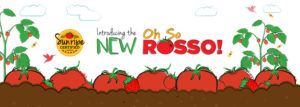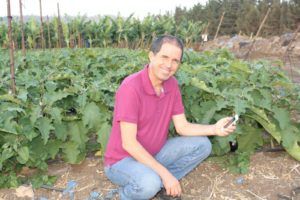Can extreme tomato farming save the planet?

Could Sunripe Certified Brands, the tomato company who helped fight modern slavery and transform the produce industry, lead its agriculture peers to tackle climate change?
Certainly Jon Esformes CEO of Sunripe is up for big challenges. The family owned company is a key partner with the Fair Food Program in improving working conditions across the tomato industry[i] while simultaneously innovating to offer new non GMO verified varieties like its “Oh so Rosso” tomatoes[ii].

Global food production is under threat from the many effects of climate change and is especially impacted by water scarcity. Agriculture accounts for roughly “70% of water consumption worldwide”[iii] and it is projected that “by 2030 overall demand for water may outstrip supply”[iv] California was particularly hard hit by a severe drought in 2015 which led the farming industry to suffer dramatic losses. The USDA reported decrease of nearly 17 percent in output” and “a revenue loss of $9.6 billion in a single year. That equates to erasing the total sales of eBay”[v]. In Mexico agriculture accounts for 77% of water use and water scarcity is so serious that the government launched a campaign titled: “The City May Run out of Water”[vi].
Sunripe Certified which represents Pacific Tomato Growers has production in California, Florida, and Mexico and will continue to be affected by these impacts of water scarcity. Currently they are employing precision agriculture techniques to reduce their use of water and partnering with local water municipalities to ensure effective water management. In Florida, Pacific Tomato “reduced runoff into the Myakka River by nearly 90% with a unique reuse and recycle water system”[vii] that used drip irrigation embedded under the soil’s surface.
Despite improvements in water efficiency and reduction, Sunripe’s production will remain at risk given the significant depletion of aquifers in its growing regions. To further safeguard against these risks Sunripe should implement methods fit for more extreme conditions including:
Dry Farming –No H2O Needed:
Dry farming eliminates the need for water in tomato production and enhances flavor. While it requires careful management of microclimates, it is an established practice for other crops such as olives and produces better yields than irrigated crops during a drought given the sturdy exterior the plant develops[viii].
CropX – Smart, On Demand Drip Irrigation:
With three sensors and a mobile based app CropX has caused a step change in drip irrigation. CropX “generates daily irrigation maps and automatically applies the right amount of water to different parts of the same field, resulting in lower water and energy usage”[ix] Such an approach dramatically improves a manager’s visibility, analysis and decision making speed creating in essence a digital farm at their fingertips.

Hydroponic Greenhouses – No Soil, Powered by the Sun.
Moving production to regional greenhouses adjacent to customer distribution centers would dramatically reduce energy, water, and transportation costs. This could enable Sunripe to set up operations outside of water constrained areas and reduce lead times to customers thereby improving freshness and extending shelf life. Other tomato competitors such as Sundrop are experimenting with innovative models. Sundrop’s groundbreaking greenhouse which launched this October uses solar power and sea water to grow 15,000 tons of tomatoes a year to supply the Australian retailer Coles[x].
AI – Robots for Agriculture
Sensor networks and autonomous mobile robots have the potential to make greenhouses largely self-sufficient. Robots that manage planting, watering, weeding, and harvesting are currently under development thanks to funding by the EU[xi]. Greenhouses are well positioned to integrate such systems given the confined space and ability to install tracks to plan robot’s routes. By incorporating artificial intelligence into its greenhouses, Sunripe could maintain centralized visibility to production while greatly reducing the need for daily manual labor to maintain these new facilities.
Robots harvesting bell peppers
While these solutions may seem extreme for a family run company like Sunripe, we must ask ourselves, how else will we stand a chance against the magnitude of climate change?
(620 words)
[i] New York Times/Steven Greenhouse. 2014. In Florida Tomato Fields, a Penny Buys Progress. [ONLINE] Available at: http://www.nytimes.com/2014/04/25/business/in-florida-tomato-fields-a-penny-buys-progress.html#. [Accessed 3 November 2016].
[ii] The Packer/Ashley Nickle. 2016. Sunripe introduces Oh So Rosso tomato. [ONLINE] Available at: http://www.thepacker.com/news/sunripe-introduces-oh-so-rosso-tomato. [Accessed 3 November 2016].
[iii] Worldometers/Aquastat United Nations. 2016. Water consumed this year. [ONLINE] Available at: http://www.worldometers.info/water/. [Accessed 3 November 2016].
[iv] Giulio Boccaletti, Sudeep Maitra, and Martin Stuchtey, “Transforming Water Economies,” McKinsey & Company, 2012 [ONLINE] Available at: http://mckinsey.com/~/McKinsey/dotcom [Accessed 3 November 2016].
[v] Inland News Today. 2016. Figures confirm drought’s impact. [ONLINE] Available at: http://www.inlandnewstoday.com/story.php?s=43965. [Accessed 3 November 2016].
[vi] Krebs M, 2009. “Water shortage in Mexico City could echo the global water issue“, Digital Journal. Retrieved 3 November 2016
[vii] Growing Produce/Growing Produce Staff. 2008. 2008 Grower Achievement Award Finalists. [ONLINE] Available at: http://www.growingproduce.com/vegetables/grower-achievement-award/2008-grower-achievement-award-finalists/. [Accessed 3 November 2016].
[viii] CUESA/Brie Mazurek. 2012. Farming without water. [ONLINE] Available at: http://www.cuesa.org/article/farming-without-water. [Accessed 3 November 2016].
[ix] Israel 21c/Abigail Klein Leichman. 2015. What’s next for drip irrigation?. [ONLINE] Available at: http://www.israel21c.org/whats-next-for-drip-irrigation/. [Accessed 3 November 2016].
[x] ABC News/Kerry Staight. 2016. Sundrop Farms pioneering solar-powered greenhouse to grow food without fresh water. [ONLINE] Available at: http://www.abc.net.au/news/2016-10-01/sundrop-farms-opens-solar-greenhouse-using-no-fresh-water/7892866. [Accessed 3 November 2016].
[xi] Robohub/Sparc. 2016. Farming with Robots. [ONLINE] Available at: http://robohub.org/farming-with-robots/. [Accessed 3 November 2016].




@Soup- I used to work in this industry, so I found your post incredibly relevant. I helped source and buy the tomatoes for Target stores across the country for 2 years. I saw firsthand how water scarcity impacted our tomato supply and pricing; a bad drought/dry season could make or break your sales! Since I only worked for one retailer, I never realized the significance this had across the industry – $9.6B far exceeds what I had expected. What was interesting about working with tomatoes is that tomatoes are a produce staple; the customer expects them to always be available at her store at a low price. Even though it could be due to weather fluctuations, it was unacceptable to have empty shelves or to charge the customer more than she expected to pay (so we couldn’t just increase our retail prices if our costs went up; it was often a direct hit to our margin).
After we repeatedly faced these types of issues, we eventually moved to a hot house tomato program. Growing these tomatoes via greenhouse and taking control of the climate in this indoor environment, we could grow tomatoes year-round. The quality of the produce was also improved, and we saved hundreds of thousands of dollars in markdowns.
I thought it was interesting that you proposed sensor networks and autonomous robots to make green houses self-sufficient. When I worked with the farmers who supplied Target, I found that there was not that much innovation in the industry. Farmers tended to have done things the way it had always been done in the past; they’d been taught a way of doing things and it was hard to bring in expensive advanced technologies to these rural locations. For this reason, I’m a bit skeptical that sensor networks and autonomous robots are going to be widely used any time soon, but it would be interesting to see what the industry looks like in the future, and if these practices become mainstream.
Erica–
As someone who hasn’t worked with farmers (but still wrote a post for this assignment all about their resistance to change), I found your comments about farmers’ discomfort with innovation quite interesting. Given the number of posts on innovation in the agricultural space (Cargill, Olam, Fonterra, Intrexon, Sunripe, etc.), it seems to be that one of two things must be true: either A) investment in agricultural innovation has become really frothy and very few of these companies/technologies will prove viable in the long run, or B) traditional agribusiness is poised for a major disruption.
Companies like Sunripe and AeroFarms (a New Jersey-based vertical farm) may require significant startup capital, but if their conservation efforts are successful (ie, they prove energy and water efficient at scale), then it’s difficult to see how traditional farmers will be able to compete in the long run. While disruption of more resilient, mass-produced cereal crops (corn, wheat, and soy) may still be a long way off, hydroponic and aeroponic greenhouses located near major cities may soon dominate production of other types of foods (eg, tomatoes).
I really enjoyed this article, as I have no previous exposure to Sunripe, and find their work with the Fair Food Program to be very inspiring. I wonder if future efforts towards environmental sustainability and innovation will conflict with this at any point. I’ve read past articles about the high percentage of U.S. families–particularly immigrants–who rely on agriculture for a source of income. It’s fantastic that Sunripe has taken a stand in an industry that is known for treating farm workers unfairly, and it would be a shame if they eventually replace manual labor with sensors and robots. I would also wonder what magnitude of capital investment dry farming or AI requires, and how Sunripe would justify that considering the fact that they have less than 200 total employees, and that they operate in a very low margin business.
This article was particularly illustrative for someone coming from an emerging market – with little idea of the interesting innovations happening in a crop as mundane as the tomato. I really appreciate the fantastic ideas you propsed – but I was wondering how practical these ideas are in a real world context. For instance the Hydroponic Greenhouses – do you think the they are actually cost competitive or is this just a PR/innovation ploy for Sundrop ? At the broader level – your analysis of the impact of water scarcity was enlightening. Do you think that developed countries like the US have some responsibility to help pass on such innovative water use practices to developing countries that grow a lot of food? This could have a manifold impact on freshwater consumption worldwide.